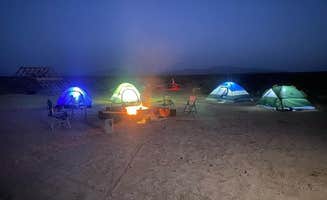Primitive tent campsites near Ridgecrest, California offer varying degrees of solitude and access to natural surroundings in the high desert. Daytime temperatures can reach over 100°F in summer months while dropping below freezing during winter nights. Most sites sit at elevations between 2,500-5,000 feet, requiring campers to prepare for significant temperature fluctuations within a single 24-hour period.
What to do
Explore ghost towns: The Ballarat Ghost Town area provides a unique historical camping experience with nearby BLM land for dispersed camping. One camper noted, "Campground had some nice spots for dry camping. I planned to stay on BLM land off the road but this seemed part of the ghost town private property" (Ballarat Ghost Town).
River fishing: Kern River access points near several campgrounds offer productive fishing opportunities. According to a review of Hobo Campground, "Absolutely love this campground. We will definitely go back. A peaceful and nice clean campground. Great fishing!" This activity provides a cool respite during hot summer months.
Off-road trail exploration: The area surrounding Live Oak South campground features extensive trail networks designed for motorized recreation. A camper explained, "It is also an off-roading area for sport bikes and the like so there are trails all through out for it" (Live Oak South — Sequoia National Forest).
What campers like
Privacy between sites: Despite being an established campground, Live Oak South offers ample space between campsites. As one visitor reported, "All the campsites are pretty spaced out so you'll have your privacy." This spacing allows for a more remote feeling while still providing designated camping areas.
Campfire options: Vakinheim provides one of the few reliable fire options in the area when seasonal restrictions allow. A camper shared, "We had an area where we could set up bon fire. Had some wood on the area" (Vakinheim).
Hot springs access: Some locations provide day access to natural hot springs. A visitor to Hobo Campground mentioned, "There are places to camp further up the road as well as more hot springs," suggesting multiple soaking options for campers willing to explore beyond the main sites.
What you should know
Seasonal closures: Several campgrounds experience periodic or indefinite closures due to infrastructure issues. Regarding Hobo Campground, a camper warned, "Hobo is amazing! Unfortunately, went to camp there last weekend and were informed the bridge has been washed out and camp is closed with no plans to repair the bridge" (Hobo Campground — Sequoia National Forest).
Wildlife awareness: The desert environment hosts numerous wildlife species that require caution. Beyond rattlesnakes, campers should watch for scorpions, black widow spiders, and coyotes, particularly at dawn and dusk.
Limited stay duration: Many sites near Ridgecrest have specific stay limits. A camper noted about Live Oak South, "This is a recreational area you can stay at for up to 14 days." Bureau of Land Management dispersed camping areas typically enforce similar limitations.
Tips for camping with families
Security considerations: Some camping areas may have security concerns. A visitor to Hobo Campground reported, "Went there awesome spot... jad an unfortunate intruder and stole things from our campsite." Camp valuables should be secured and children supervised.
Water planning: With extremely limited water sources, family camping requires careful planning. Pack 1-2 gallons per person per day, with additional water for cooking and cleaning. No potable water is available at most sites.
Shade structures: Most tent campsites near Ridgecrest lack natural shade. Families should bring portable canopies or shade structures, particularly when camping with small children or during summer months (Long Valley Campground).
Tips from RVers
Limited facilities: RV camping options are restricted to sites that can accommodate larger vehicles. Live Oak South allows RVs but provides no hookups. The campground is listed as "big-rig friendly" but visitors should expect primitive conditions.
Generator restrictions: Most campgrounds in the area prohibit generators, requiring RVers to be self-sufficient with solar or battery power. Even at campgrounds where generators are technically allowed, quiet hours are strictly enforced.
Road conditions: Access roads to many camping areas are unpaved and may be rough. RVers report better conditions accessing Live Oak North (Live Oak North Campground), which offers more developed facilities including showers and toilets, though still no hookups.


